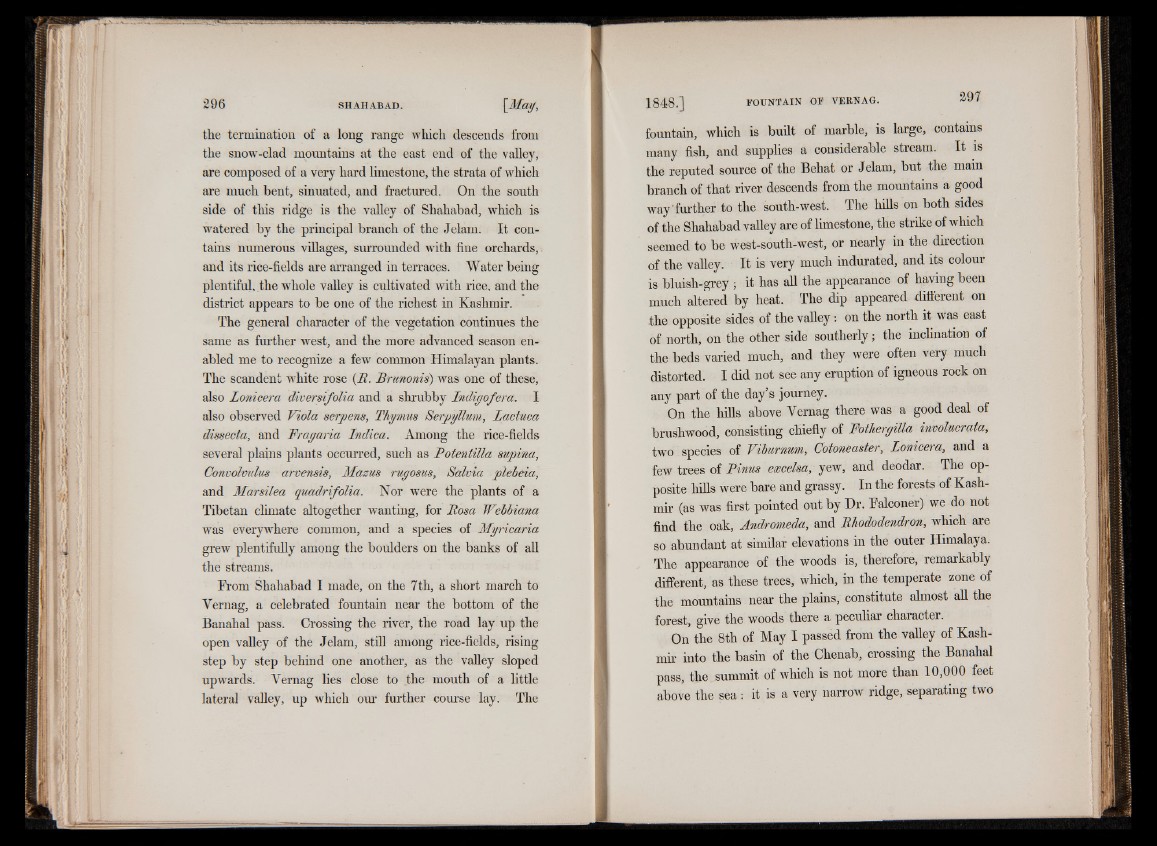
the termination of a long range which descends from
the snow-clad mountains at the east end of the valley,
are composed of a very hard limestone, the strata of which
are much bent, sinuated, and fractured. On the south
side of this ridge is the valley of Shahabad, which is
watered by the principal branch of the Jelam. It contains
numerous villages, surrounded with fine orchards,,
and its rice-fields are arranged in terraces. Water being
plentiful, the whole valley is cultivated with rice, and the
district appears to be one of the richest in Kashmir.
The general character of the vegetation continues the
same as further west, and the more advanced season enabled
me to recognize a few common Himalayan plants.
The scandent white rose {B. Brunonis) was one of these,
also Lonicera diversifolia and a shrubby Indigofera. I
also observed Viola serpens, Thymus Serpyllum, Lactuca
dissecta, and Fragaria Indica. Among the rice-fields
several plains plants occurred, such as Botentilla supina,
Convolvulus arvensis, Mazus rugosus, Salvia plebeia,
and Marsilea quadrifolia. Nor were the plants of a
Tibetan climate altogether wanting, for Bosa Webbiana
was everywhere common, and a species of Myricaria
grew plentifully among the boulders on the banks of all
the streams.
From Shahabad I made, on the 7th, a short march to
Vemag, a celebrated fountain near the bottom of the
Banahal pass. Crossing the river, the road lay up the
open valley of the Jelam, still among rice-fields, rising
step by step behind one another, as the valley sloped
upwards. Vemag lies close to the mouth of a little
lateral valley, up which our further course lay. The
fountain, which is built of marble, is large, contains
many fish, and supplies a considerable stream. It is
the reputed source of the Behat or Jelam, but the main
branch of that river descends from the mountains a good
way further to the south-west. The hills on both sides
of the Shahabad valley are of limestone, the strike of which
seemed to be west-south-west, or nearly in the direction
of the valley. It is very much indurated, and its colour
is bluish-grey ; it has all the appearance of having been
much altered by heat. The dip appeared different on
the opposite sides of the valley: on the north it was east
of north, on the other side southerly; the inclination of
the beds varied much, and they were often very much
distorted. I did not see any eruption of igneous rock on
any part of the day’s journey.
On the hills above Vemag there was a good deal of
brushwood, consisting chiefly of Fothergilla involucrata,
two species of Viburnum, Cotoneaster, Lonicera, and a
few trees of Pinus excelsa, yew, and deodar. The opposite
hills were bare and grassy. In the forests of Kashmir
(as was first pointed out by Dr. Falconer) we do not
find the oak, Andromeda, and Rhododendron, which are
so abundant at similar elevations in the outer Himalaya.
The appearance of the woods is, therefore, remarkably
different, as these trees, which, in the temperate zone of
the mountains near the plains, constitute almost all the
forest, give the woods there a peculiar character.
On the 8th of May I passed from the valley of Kashmir
into the basin of the Chenab, crossing the Banahal
pass, the summit of which is not more than 10,000 feet
above the sea : it is a very narrow ridge, separating two